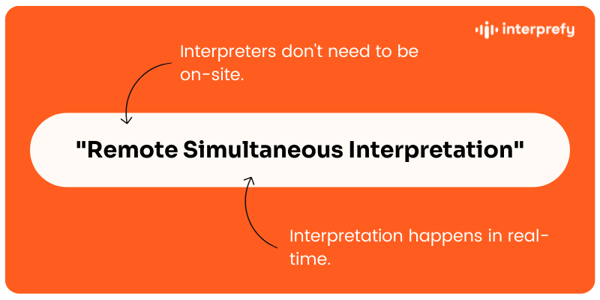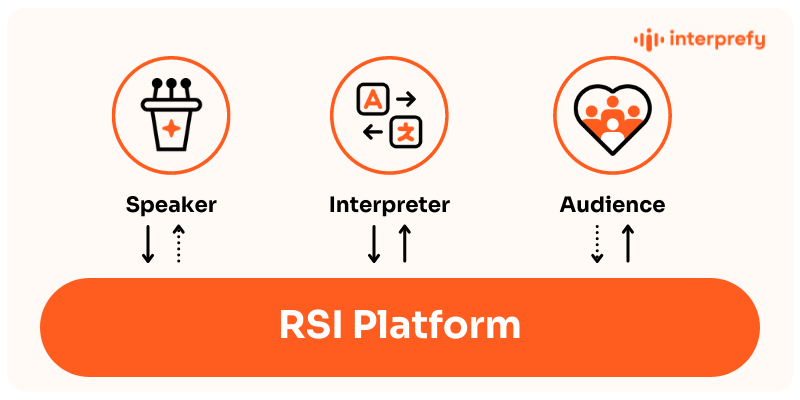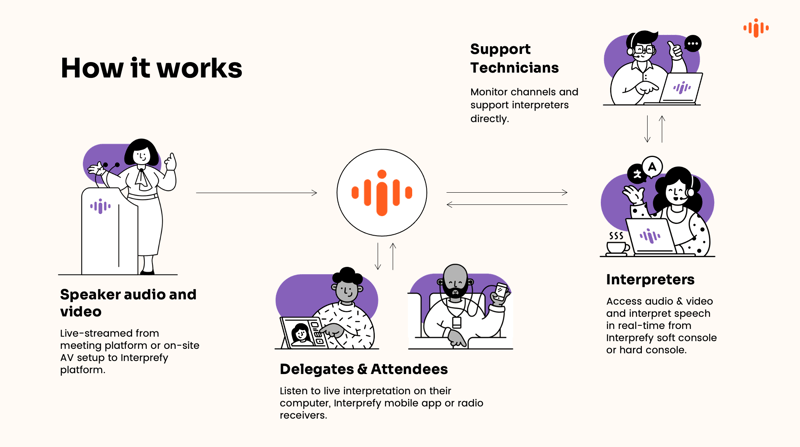3. Benefits of Remote Simultaneous Interpretation
Before we dive into the benefits of remote simultaneous interpretation, let's first take a look at the limitations of traditional modes of delivering conference interpretation:
3.1. Limitations of traditional conference interpreting setups:
- Cost - Delivering traditional conference interpretation comes with several layers of cost - from travel and accommodation costs for interpreters to renting interpreter booths and radio receivers for listeners.
- Attainability - Due to the complexity and cost associated with traditional conference interpretation, this used to be a service only available to governments, large NGOs, and large multinationals.
- Floor space & scalability - Conferencing venues only have so much space that can be used for setting up interpreter booths. That also meant the number of languages for a conference was limited by the available floor space.
- Technical complexity - AV and conferencing systems, booths, hard consoles, and radio receivers - setting up an on-site interpretation installation is far from easy.
- Sustainability - Travel, lodging, food and beverage, and energy are the biggest factors in any events' carbon footprint.
3.2. Benefits for event organizers
Remote Simultaneous Interpretation has managed to successfully solve all of the above issues by taking interpretation into the cloud.
RSI platforms enable easily accessible multilingual events, both online and offline. At the same time, RSI increases flexibility and scalability by enabling entirely virtual or hybrid setups, with some interpreters working on-site from booths and remotely at the same time.
RSI brings many advantages for multilingual events and meetings:
More scalability
RSI can be scaled to accommodate thousands of listeners, unlimited language requirements, and multiple access points.
Fewer costs
How much does remote simultaneous interpretation cost? The answer to this question will depend on the size of your event, number of languages, and amount of interpretation hours, among other factors. However, one thing is clear; RSI can help in reducing layers of the cost associated with conference interpreting, from no booth to rent, to no interpreter travel and accommodation costs.
Reduced communication barriers everywhere
RSI can help to connect listeners and speakers in their own language, no matter where they are located.
Fewer carbon emissions
Eliminating travel requirements can support event organisers in their efforts to reduce their event's carbon footprint.
Compatibility with any platform
Making interpreting available anywhere and on any platform.
ISO-certified security
RSI providers like Interprefy provide ISO 27001-compliant information security standards and enterprise-grade security features to govern access.
Additional remote simultaneous interpreting services
Through RSI technology, multilingual captions, as well as event recordings for post-event usage, can be provided.
Analytics
Live statistics of interpretation usage can be made available by the RSI provider.
Dedicated support
Dedicated support technicians can support interpreters and event organizers to ensure a flawless setup and seamless experience.
3.3. Benefits for interpreters
Dedicated support and fewer technical issues to worry about
RSI platforms like Interprefy support interpreters every step of the way, from platform training to setup and sound-checks before the event starts. During the event, dedicated support technicians maintain a direct line with interpreters to assist with technical difficulties.
Fewer logistics, more interpreting
Instead of wasting time on booking tickets, finding housing, and traveling to different countries, the remote work allows for more flexibility in choosing assignments, attending more events, and finding more time to connect with family and friends.





.webp?width=468&quality=high)












 More download links
More download links



